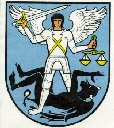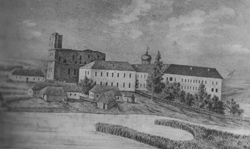|
Kraziai is a small farm town in western Lithuania, a
region known as Samogitia. The town, on the Krazante
River, lies between
 Varniai and Raseiniai. Its population in
1959 was 998, down from about 2000 in 1939 and 16,113 in 1923.
Under the Republic of Lithuania, Kraziai was the township seat
of Raseiniai County. After World War II, the
Soviets assigned it to the administrative district of Kelme. Varniai and Raseiniai. Its population in
1959 was 998, down from about 2000 in 1939 and 16,113 in 1923.
Under the Republic of Lithuania, Kraziai was the township seat
of Raseiniai County. After World War II, the
Soviets assigned it to the administrative district of Kelme.
Kraziai is one of
the oldest settlements in Samogitia, with many barrow graves and
fortress hills. To the north is Medziokalnis Hill, which
according to legend, was the home of the forest goddess Medeine. A royal
document from 1257 assigned to the Teutonic Order a part of
Samogitia and mentioned the town. Later, Vytautas Magnus ceded
Samogitia to the Teutonic Order. After the Battle of Tannenberg in
1410, Samogitia regained its freedom and Kraziai became the
district center.
In the 16th
century, the magnate family of Kesgaila ruled Kraziai, which
became the seat of the elder of Samogitia. Samogitian nobles
assembled for inspection in Kraziai before going to war. With
the death of the last Kesgaila family member in 1556, Kraziai
reverted to the state. In 1559, King Sigismund Augustus sold it
to Catherine of Suffolk and her husband Richard Berth for 3,676
Dutch thalers. When the pair returned to England five years
later, Nicholas Radvilas (Radziwill), Palatine of
Vilnius, reimbursed them the purchase price and took over Kraziai's
administration. Early in the 19th century, part of Kraziai was
assigned to General J. Judicki. In 1865, the town numbered
1,450. By 1897, it had 1,761 inhabitants.
Kraziai was a
religious and cultural center, with an ornate parish church
dating from 1416, a Jesuit church and a church belonging to the
Benedictine Sisters. Jesuit priests from Vilnius established in
Kraziai a mission in 1608, a college in 1616 and a church in
1621. The church altar was decorated with a copy of Da
Vinci's Assumption of the Blessed Virgin Mary. The Jesuit church
ceased operating in 1821. The Benedictine Sisters built in
Kraziai a wooden church and convent in 1641 and a brick
church in 1763. In 1893, the Russians shut down monasteries
and forced the Benedictine Sisters to Kaunas. Locals
defended the church in what subsequently became known as the
Massacre of Kraziai.
The old
parish church, destroyed many times by fire and each time
rebuilt, exists today only in historical records. The church
today dates from the early 19th century.
Kraziai was an
educational hub for almost two centuries. The Jesuit
college operated from 1614 to 1773, when the pope disbanded the
 Jesuit Order. The Carmelites of the Kolainiai
Friary administered the college from1797 to 1817. The
school contained 500 students, a library of 3000 volumes and a
physics laboratory. In 1817, the Carmelites returned the school
to the Educational Commission, which owned it beginning in
1773. The college, now a district school, was supervised by the
University of Vilnius and later Kaunas. In 1823, the
school had 16 teachers, 450 students and a library of 5,000
volumes. Prominent graduates include S. Stanevicius, D. Poska,
L. Jucevicius (Jucewicz), Antanas and Jonas Juska and A.
Fromas-Guzutis. Jesuit Order. The Carmelites of the Kolainiai
Friary administered the college from1797 to 1817. The
school contained 500 students, a library of 3000 volumes and a
physics laboratory. In 1817, the Carmelites returned the school
to the Educational Commission, which owned it beginning in
1773. The college, now a district school, was supervised by the
University of Vilnius and later Kaunas. In 1823, the
school had 16 teachers, 450 students and a library of 5,000
volumes. Prominent graduates include S. Stanevicius, D. Poska,
L. Jucevicius (Jucewicz), Antanas and Jonas Juska and A.
Fromas-Guzutis.
As new roads and
railroads bypassed Kraziai, it declined. Its population
grew during the brief period of Lithuanian independence but
after World War II decreased to one thousand. Today it is a
small farming village. The college is being rebuilt and will
house a museum. |



